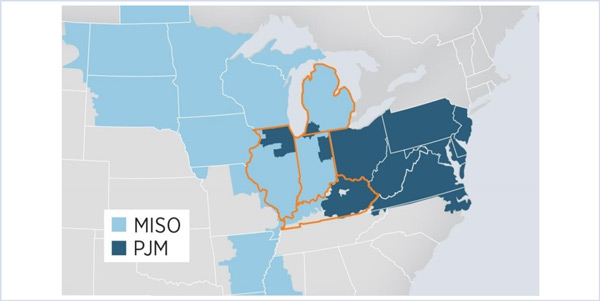By Amanda Durish Cook
CARMEL, Ind. — EPA’s Clean Power Plan may be undone by the Trump administration, but MISO and PJM officials say their recently completed study on the rule yielded some valuable insights nonetheless.
“The CPP provides a good stress test to illustrate not only the value of interregional coordination but state coordination, as new policies and/or regulations are considered,” the RTOs opined in the study, which was released last week.
The study examined Michigan, Indiana, Illinois and Kentucky — states on the RTOs’ seam — and focused on transmission congestion, generation mix, production costs and economic trading.
PJM Net Exporter
Coal retirements and new combined cycle gas additions would make PJM a net exporter of power to MISO by 2030 because PJM’s gas additions “are located much closer to shale formations and thus have a lower fuel delivery basis and lower operating cost than the MISO resources,” according to the study. Over the last five years, the net scheduled interchange between the two regions has varied, with each at times being a net seller.
The study also found that transmission congestion costs would rise by between $1.1 billion and $1.8 billion between 2025 and 2030 if the CPP is enforced. The increase is owed to higher fuel prices and load, new generation constructed without transmission reinforcements, outages and policy decisions that shift the locations of the most economic sources of generation.
It projects LMPs would be between $54 and $70/MWh by 2030, with MISO having a slighter higher LMP than PJM under all CPP scenarios.
The report identified three variables — natural gas prices, the geographic scope of emissions trading and how much energy efficiency can count toward compliance — as “key drivers” and used them as sensitivities in the study.
Gas Price Impact
The analysis agreed with previous CPP studies by the RTOs that concluded that the cost of natural gas would be the biggest single determinant in the cost of compliance. “The price of natural gas has by far the biggest impact,” MISO Senior Policy Studies Engineer Jordan Bakke said at a March 15 Planning Advisory Committee meeting. (See PJM: Regional Plan Cuts Costs, but Gas Prices are Wild Card for CPP Compliance.)
The study found that standardizing state energy efficiency measurement and verification rules would allow commoditization of credits across broader markets, helping to offset deployment costs. “Non-similar state policies can drive significant economic distortions along the MISO-PJM seam and exacerbate transmission cost impacts,” the report said. “Conversely, the ability to transact fungible products amongst states results in greater market efficiency.”
Both RTOs used previous analyses for the study, MISO bringing its 2017 Transmission Expansion Plan policy regulations future and PJM supplying its September 2016 CPP study. The earlier studies showed that state emissions credit trading resulted in “lower costs, fewer generation retirements and more efficient generation investment.”
MISO and PJM began the study six months ago, after the CPP was stayed by the Supreme Court but before Trump’s election. “The political landscape was a lot different a year ago,” Bakke acknowledged. “But we still find value in this entire exercise.”
Bakke said the analysis would only be used for informational purposes at this point and would not influence MTEP 18 futures. He also said the study could become a template for future cross-RTO policy analyses.
The study is the first policy-focused study MISO has ever completed with another RTO, according to Bakke. “I think this helped open the lines of communication,” he said.
Both MISO and PJM said the study should not be viewed as a recommendation for complying with the CPP. “However, states, utilities and other entities can consider the observations made from this analysis within the specific context of the CPP or in a broader context as they consider other policy goals that can influence already dynamic economic interactions in electric markets,” they wrote.


